Pursuit of Safety Performance to “Protect Human Life"
Initiatives to Achieve Our Goal of Zero Fatal Traffic Accidents in 2030
SUBARU’s All-Around Safety
Attaching particular importance to protecting lives, Subaru is working to achieve our target of zero fatal traffic accidents1 in 2030.
Subaru will enhance the safety performance of its cars from every perspective as we aim to achieve zero fatal traffic accidents in 2030. We will do this by making the four existing areas of Primary Safety, Active Safety, Preventive Safety, and Passive Safety even better, while also adding Connected Safety.
*1:Zero fatal road accidents among occupants of Subaru vehicles and people involved in collisions with Subaru vehicles, including pedestrians and cyclists
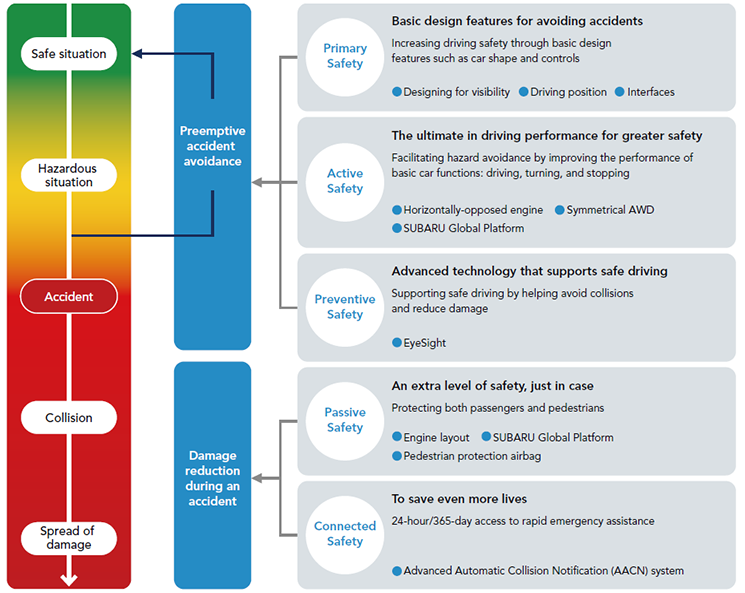

Evolution of EyeSight Driver Assist Technology
Subaru believes that to attain zero fatal traffic accidents in 2030, it is crucial to offer exceptional performance at a price that is affordable for a wide range of customers. Subaru’s EyeSight Driver Assist Technology, which was introduced in Japan in 2008 and achieved cumulative global sales of 5 million units in June 2022, has continued to evolve over the course of 15 years.
The stereo cameras equipped in EyeSight enable the system to recognize objects with two cameras, similar to human eyes, detecting items on the road at a higher level than radar-based systems. The development of EyeSight began approximately 30 years ago. During the early stages, there were frequent issues with the system’s ability to detect objects properly, particularly when it was raining or the windows were foggy. However, these challenges were overcome through extensive testing in various real-world scenarios and subsequent improvements.
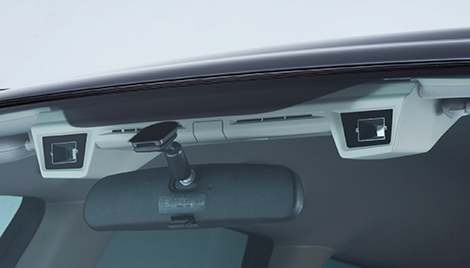
First-generation EyeSight introduced in 2008
The EyeSight system was launched in 2008, achieving a world first in using solely stereo camera technology to enable pre-crash braking and adaptive cruise control. EyeSight version 2 was announced in 2010 with an enhanced pre-crash braking system that provides support until the vehicle comes to a full stop. During this period, EyeSight became a standard feature in numerous models for the Japanese market, and its affordability contributed to a significant increase in its recognition and widespread adoption among customers. In addition, it began to be developed in certain models overseas as well.
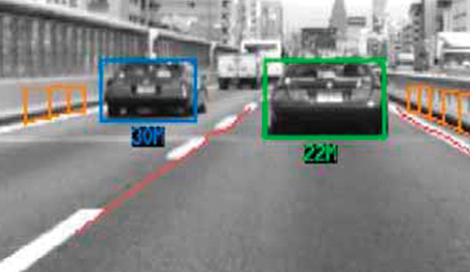
Image depicting EyeSight’s recognition capability
In 2014, with the release of version 3, advancements in color recognition and an expanded field of view using stereo cameras significantly enhanced the advanced safety features. In the 2020 release of the Levorg, Subaru introduced EyeSight X, combining a new stereo camera with four radars in the front and rear, and a highprecision map locator.
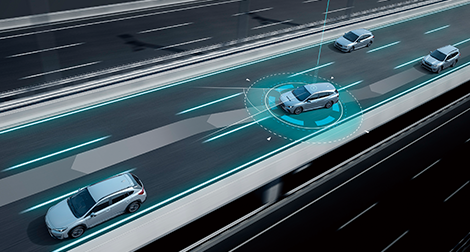
Illustration of EyeSight X capability
In 2022, we newly adopted a wide-angle single lens camera for enhancing EyeSight’s recognition capability in the mainstay Outback for the North American market. Through its evolution into a “three-eyed” system with stereo cameras and an ultra-wide-angle single lens camera, EyeSight can now recognize a significantly wider range. This enhancement enables collision damage reduction through pre-crash braking for situations where pedestrians and cyclists, often at higher risk of accidents at intersections, might emerge from a driver’s blind spots.
While there were other options available to achieve accident reduction in these scenarios with pre-crash braking, Subaru chose to utilize the wide-angle single lens camera to provide the highest level of safety at an affordable price for customers. EyeSight is currently integrated into the Crosstrek and Impreza for the Japanese market, with plans for a gradual rollout to other models in the future.
EyeSight and AI combine to Enhance Preventive Safety
Subaru is committed to enhancing its preventive safety technologies and is actively exploring new technologies as it strives to achieve zero fatal traffic accidents. Our current focus is on integrating AI technology with EyeSight.
The fundamental principle of spatial recognition using stereo cameras is to precisely calculate the distance to objects from each pixel by triangulating the displacement of images captured by the two cameras, one on the right and one on the left. The strength of EyeSight lies in its ability to accurately convert everything captured by the cameras into a three-dimensional representation, allowing it to perceive the shape and distance of various objects. However, when it comes to capturing small objects or subtle irregularities, determining whether to pass over them or consider them obstacles solely based on EyeSight‘s image recognition can be challenging. In contrast, AI excels at precisely categorizing objects captured in camera, pixel by pixel, based on extensive previously learned data. Since EyeSight can fuse the distances to recognized objects with the classifications made by AI in the same image, EyeSight and AI are considered an excellent match. If this can be put into practical use, it is expected to lead to an enhanced level of vehicle safety in various situations by allowing for more detailed and accurate recognition of the driving environment’s information than ever before.
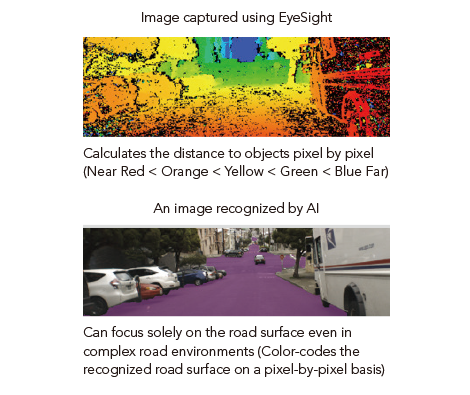
This initiative is being carried out at the Subaru Lab, which was established in December 2020. To create an environment that generates new ideas from unconventional perspectives, we decided to establish a separate dedicated office. This new stand-alone base in Tokyo’s Shibuya, an area increasingly seen as an IT hub following recent redevelopment efforts, has enabled us to streamline and effectively recruit the talent essential for AI development. While our current focus is on AI technology, we aim to continue advancing our development by actively incorporating not only AI but also new technologies in the future.
In April 2024, Subaru announced that it would adopt Versal™ AI Edge Series Gen 2 of AMD as the SoC to be used in the next-generation AI-powered EyeSight under development at Subaru Lab, and that Subaru would begin collaborating with AMD on circuit design to optimize the SoC2 in order to achieve cutting-edge AI inference performance and ultra-low latency computing at a low cost. Toward the goal of zero fatal traffic accidents, we are committed to semiconductor circuit design for SoC optimization to further evolve EyeSight functions at an affordable price for our customers.


*2:
Subaru and AMD Collaborate on SoC Design to Integrate Stereo Camera and AI
Inference for the Next-Generation EyeSight
(April 19, 2024)
(https://www.subaru.co.jp/news-en/2024_04_19_154452/)
Continuous Enhancement of Passive Safety
Subaru focuses on developing cars with the utmost priority of safeguarding everyone in the event of a collision, not just the vehicle occupants but also pedestrians and cyclists.
Strengthening the vehicle body and enhancing restraint systems are two critical elements to occupant protection. In strengthening the vehicle body, we combined a cabin structure that can withstand severe collisions by using high-strength materials with the Subaru Global Platform, which helped realize a body structure that efficiently absorbs collision energy. This design ensures protection in collisions from any direction.
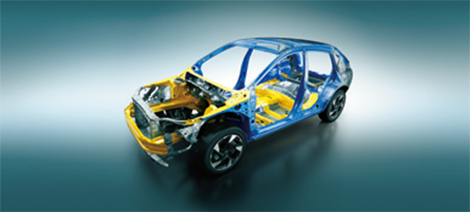
In enhancing restraint systems, we reduce the load on the upper body by firmly restraining the lower body with knee airbags and seat cushion airbags. We also adjust the seatbelt tension based on the occupant’s physique to prevent excessive pressure. This ensures the protection of all occupants, regardless of age or body size. Nevertheless, even with the evolution of restraint systems, they will not be fully effective unless seat belts are properly fastened. The rate of rear seat belt usage in Japan is only around 40%. Subaru has taken steps to address this situation by introducing advanced seat belt reminders and expanding the number of models equipped with them.
Pedestrians and cyclists sustain injuries at a rate 2.5 times higher than that of vehicle occupants. To reduce the damage to pedestrians and cyclists in the event of an accident, Subaru not only uses soft structures for bumpers, bonnets, and other areas that can absorb impacts but also equips its vehicles with pedestrian airbags.
In the pursuit of zero fatal traffic accidents, it is necessary to anticipate more diverse and severe accidents than ever before, however. For example, in collisions involving bicycles, it has been recognized that under certain limited conditions, the current pedestrian airbags may not cover all cases, given the various factors such as the cyclist’s physique and the orientation and speed of both the bicycle and the vehicle at the time of impact. As a result, we are utilizing computer simulations to identify worst-case scenarios from the countless collision patterns that can be imagined and to develop specific countermeasures.
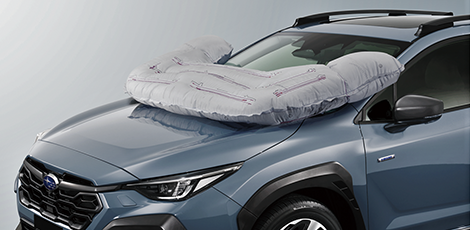
Plan to Achieve Zero-Fatality Road Safety
To achieve zero fatal traffic accidents, Subaru conducted a comprehensive investigation of fatal traffic accidents that occurred in the U.S. from 2017 to 20213, analyzing the causes of the accidents and the reasons for fatalities. Based on this analysis, we identified functionalities that can effectively eliminate these causes. Following this, we decided on specific measures to implement these functionalities and are actively engaged in their development to bring them to fruition.
Specifically, we are improving all five areas of Primary Safety, represented by excellent visibility and fatigue-free designs; Active Safety, referring to vehicles that are less likely to behave erratically with sudden driving inputs to avoid danger; Preventive Safety, represented by the pre-crash braking system in EyeSight and other features; Passive Safety, which mitigates injuries to occupants or pedestrians; and Connected Safety, symbolized by autonomous reporting post accident. We are pursuing these based on Subaru’s overall safety philosophy as part of our efforts to develop technologies to address fatal traffic accidents. We will also promote efforts to educate users about accidents that cannot be solved with vehicles alone4, propose rules, and encourage the improvement of the road environment.
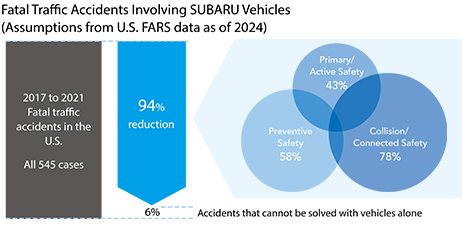
*3:All 545 cases of fatal accidents occurring while a driver or passenger is in a
Subaru vehicle and fatal accidents of pedestrians, cyclists,
and the like arising from collisions with a Subaru vehicle.
Source: Data made available on all fatal traffic accidents that occurred in the U.S. from the
Fatality Analysis Reporting System (FARS).
*4:Includes cases where the vehicle was caught between a large vehicle such as a semi trailer in the front and rear, head-on highway collisions where a vehicle was driving the wrong way, and collisions with a pedestrian who entered the highway at night.
Car Assessments
Subaru undergoes safety performance testing and assessment of public organizations in and out of Japan including JNCAP5 in Japan, IIHS6 and U.S. NCAP7 in the U.S., Euro NCAP8 in Europe, and ANCAP9 in Australia, and has gained the highest rank of assessment in most of them.
In FYE March 2024, the Crosstrek and Impreza won the JNCAP Five Star Vehicle Safety Performance 2023 Award. Furthermore, of the five star award winners, the vehicles also won the JNCAP Five Star Vehicle Safety Performance 2023 Best Award, only awarded to the vehicles earning the highest overall points. At the IIHS, as of May 2024, one of Subaru’s 2024MY (model year) vehicles had won the organization’s 2024 TOP SAFETY PICK+ (TSP+) Award, and three vehicles had won its 2024 TOP SAFETY PICK (TSP) Award. ANCAP gave the Solterra a five-star rating in its 2022 assessment.
*5:Japan New Car Assessment Program (JNCAP): An assessment operated by the Ministry of Land, Infrastructure, Transport and Tourism and the National Agency for Automotive Safety and Victims’ Aid (NASVA) to evaluate automobile safety performance.
*6:IIHS: Insurance Institute for Highway Safety
*7:U.S. NCAP: U.S. New Car Assessment Program for assessing safety performance operated by the National Highway Traffic Safety Administration (NHTSA).
*8:Euro NCAP: European New Car Assessment Programme, a safety information disclosure program for automobiles in Europe.
*9:ANCAP: The Australasian New Car Assessment Program, a safety performance assessment program conducted by an independent organization created by Australian and New Zealand transit authorities.
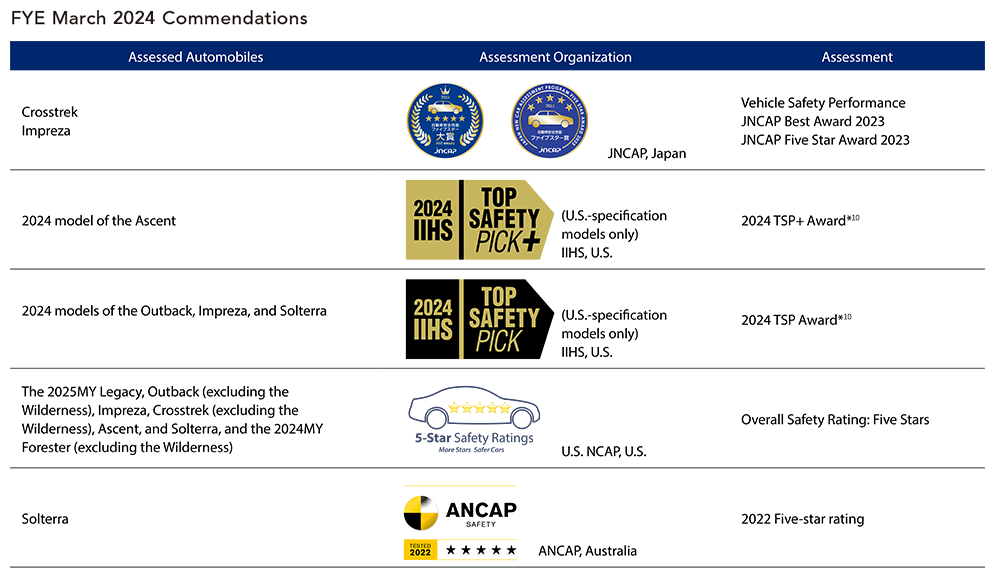

*10:In the IIHS’s publication of vehicle safety information, the TOP SAFETY PICK (TSP) Award is given to vehicles that earned the rating of “Good” in the original moderate front overlap test and small overlap tests (driver- and passenger-side) and the updated side crash test, and the rating of “Acceptable” or higher in the headlight evaluation (standard equipment), as well as the rating of “Acceptable” or higher in the daytime and nighttime vehicle-to-pedestrian crash prevention test. In addition to these ratings, vehicles that earned the rating of “Acceptable” or higher in the updated offset frontal crash test replacing the original test are awarded the TOP SAFETY PICK+ (TSP+) Award.
